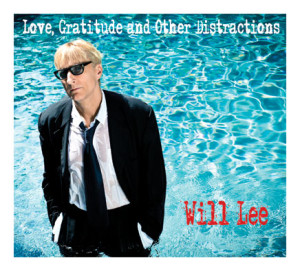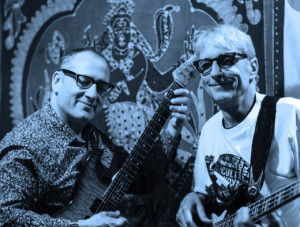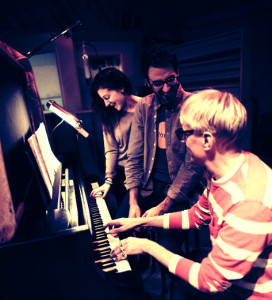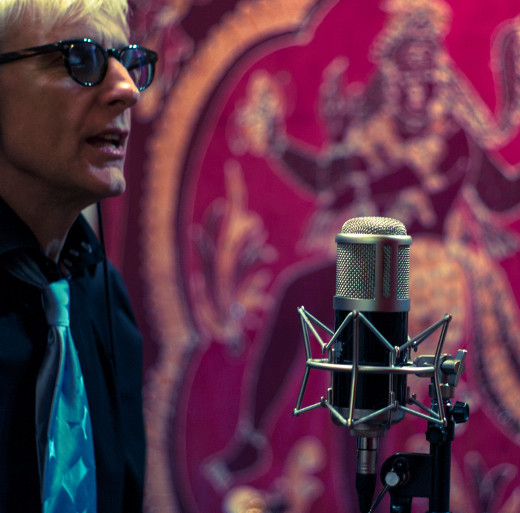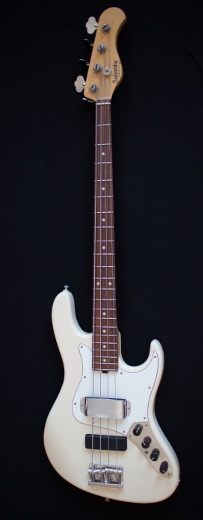Star Studios: Will Lee — Solo Satisfaction at The Beatles Museum, NYC
On a recent “Late Show with David Letterman,” longtime-band member bassist Will Lee is crooning the 1960’s classic “MacArthur Park” while laying down a punchy rhythm on his Sadowsky four-string Will Lee model bass.
Surrounded on three sides by the CBS Orchestra, with special guest Jimmy Webb, composer of the circa 1968 psychedelic orchestral epic sitting in on keyboards, Will, wearing a “stripe-ed pair of pants” (coincidentally, not unlike those described in the second verse of the song) transforms the kitschy butt-of-jokes tune (specifically, the infamous “cake out in the rain” metaphor), into a coolly earnest love song while simultaneously entertaining and stunning Late Show viewers. For the crescendo, a mammoth prop cake appears on the set and then, without missing a beat, Will ascends the ladder to the top and nails a tonsil-baring Bb in his falsetto for the final note.
Why this song of all the songs in the world?
Because Dave “wanted to see if we could pull it off, so we gave it our best shot,” Will replies.
They sure did.
It’s just another adventure in the the creative world Will resides in. After five-and-a-half decades at the top of his game, having played with three of the Beatles, he zooms around the world performing with The Fab Faux, his Beatles “cover band,” and remains one of the most in-demand bass players on the planet — Will is always game for wherever the muse may lead him.
Recently it led him to write and produce his first albumin 20 years. Entitled Love Gratitude and Other Distractions (LGOD), it was released to critical acclaim, and features a megawatt cast of musicians including Pat Metheny, Chuck Loeb, Billy Gibbons, Allen Toussaint, Narada Michael Walden, Bob James, Steve Lukather, the late Hugh McCracken and Chrissy Amphlett to name a few, lending their talents to an eclectic mix of six original songs co-written by Will, and an assortment of collaborators, as well as covers of personal favorites such as the Motown oldie 1,2,3, Allen Toussaint’s Get Out of My Life Woman (a duet with ZZ Top’s Gibbons). Paradoxically, a soulful instrumental of “Smile, “ recorded live as a bass-guitar duet with guitarist Chuck Loeb, closes the album.
SonicScoop sat down with Lee in his Chelsea, NYC, apartment where after a guided tour of his home studio, AKA The Beatles Museum, and a viewing of his cool collection of Beatles metal lunchboxes hung gallery-style on the wall above the console, he gave us the inside track into the steps in the sonic chain leading up to the final mixes of LGOD, and how he cast the amazing musicians and vocalists who appear on the project.
After all, when you know everyone in the biz, as Lee does, how do you choose who plays or sings on your music when you can have practically anyone?
What was the impetus for making this album?
After not doing anything creative on my own for some time, and being available to work for everybody else, I was starting to fill up with ideas and rather than physically explode, I thought I should start getting some of these ideas out of my system.
I had made notes on napkins, on the subway, but no matter how great an idea you have, it’s going to go away if you don’t put it down somewhere. If you don’t seize that moment, it’s gone.
Which idea or song came first?
The album began with one song. Somebody, unbeknownst to me, was recording a songwriter circle I was performing at in the Village, and played the tune back for me. It’s a real honest autobiographical song, called “Miss Understanding.” I played the recording for a friend, Tommy Allen, who liked it so much he put a new drum track down on it. I wiped off all the live performances after that and started putting new instruments down to the new drum track.
Suddenly, I thought “this could really be a thing. “ I overdubbed some more instruments and liked the way the track came out; it was better with the new drummer because whereas originally he had been following the live band when he put down the new drums, but then, when we overdubbed to his new track, it was like he was driving the bus and the subsequent overdubs had more punch. I hadn’t thought about doing an album yet; but I liked the way that song came out a lot. I thought about just putting it on iTunes.
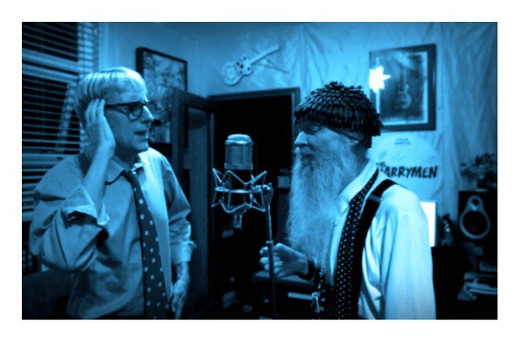
Singing “Get Out Of My Life Woman” with Billy Gibbons at The Beatles Museum studio. (Photo Credit: Sandrine Lee)
So what was the next step?
There was no master plan or theme. Things evolved organically. I just let each song take shape and looked at each one as its own little journey; it really had to have something to say on its own. Because that’s how you experience a song anyway.
Then I thought well, I have this other song, an instrumental version of Charlie Chaplin’s classic “Smile” that I figured out to play with bass and harmonics. It was just me and guitarist Chuck Loeb playing live in the studio.
“Now I have these tunes that have nothing to do with each other, “ I thought. The joke was this can’t be an album because there’s nothing relating these two tunes to each other. There’s no blanket theme going on here, except they’re all songs I like.
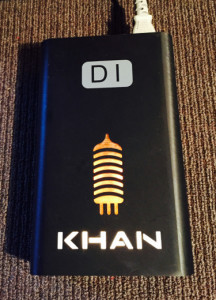
The master bassist’s input of choice: The Khan Audio All-Tube D.I. Lee: “The perfect direct box for bass and anything else!”
So what was the game plan after that?
Most of the conceptualizing was done in my home studio, aka The Beatles Museum, with me playing to a beat or a click and overdubbing. Next, I would put down certain instruments that I didn’t want to replace with real cats. Then think, “okay who would be perfect for this part of the song? “ I had them come over or I’d send them the tracks and say “please do your thing on top of it.”
A lot of cats stepped up to the plate and it was gorgeous. It would have been another kind of album if I was so organized that I could have booked a couple of days with a bunch of guys and we played together.
And THEN what happend?
Once I had an accumulation of 4-5 songs I played them for people and the dilemma was there was no overall theme connecting them. But I just wanted to do stuff I liked, and it didn’t matter that they didn’t match or fit together.
The feedback I got was that there was a thread, a similarity between the tunes because it was me doing them all. So, when I had enough tunes, I gave it a name and called it an album.
What was the producing and recording process like?
In my home studio, the process begins with a tempo because that’s what gives the song some sort of direction. Next comes the groove.
One of the luxuries of working at home is I get to look at the three dozen basses on the wall and contemplate which one is right for the song. But if I’m stuck in another studio and I’ve taken a gig bag with two basses and I wish I had the Höfner and all I have is the Fender and the Sadowsky, I’ll be sad knowing the music speaks to me about using a certain bass that not’s here.
That’s a great luxury of working at home and doing sessions there. I love when people send me their tracks; that guarantees that I’ll have the right bass handy. It won’t make or break the song, but when a song is presented to me, it speaks to me about what’s needed.
Pat Metheny plays a beautiful solo on your tune, “Gratitude.” How did that go down?
I took a chance and wrote a horn section over a great bed where the solo would go. It just felt like Pat to me. I love when he does that “synth horn-like sound” with his Roland GR-300 synth guitar. I thought that would be the perfect soaring sound for that section of the song.
I sent him the tracks and he recorded his solo in his home studio in New York. He asked me what I imagined him playing on it. I requested his synth guitar and he went to town on it. What he sent me is what ended up on the record.
Another great guitarist, Steve Lukather solos on “Natives,” a tune derived from Horace Silver’s “The Natives Are Restless Tonight.”
What’s the musical brief on that?
Steve Lukather played an amazing solo that he recorded at the CJ Vanston’s studio in LA. In his case, I had put together a solo section for him to wail on thinking he’ll know exactly what to do.
But he actually missed having someone to bounce off of. It hadn’t occurred to me that he needs the interplay. He would have wanted to bounce ideas off of me in person. Luke actually went in to the studio on two different days to nail the solo on his own accord, as he wasn’t satisfied, so “Thanks, Brother Luke!”
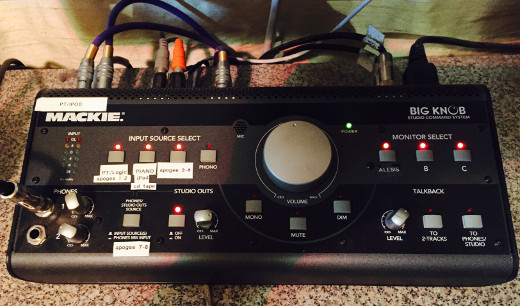
The heart of Lee’s studio isn’t a console, but a Mackie Big Knob. “It’s a simple solution to monitoring, recording, and playback scenarios, as well as having a built-in talkback mic!” he says.
Let’s talk about some of the vocals. You sing lead on all the vocal tunes; how did you choose who would sing the duets with you? What made you choose them?
I woke up one morning with “Get Out of My Life Woman” in my head. I was singing it to my wife, Sandrine, when Billy Gibbons [lead singer with ZZ Top] called and said he was in town.
I said “Billy, I have an engineer coming over tonight” and invited him to come over and sing the song with me. He answered, “I have a terrible cold. I want to get this recorded before it goes away.” Any other singer would have said, “Not today”! (Note: Billy inducted Will into the Musicians Hall of Fame, in January 2014. Check out the video to hear the results, and see more of the studio in action.)
How did Akiko Yano end up singing a duet with you on “1,2,3“?
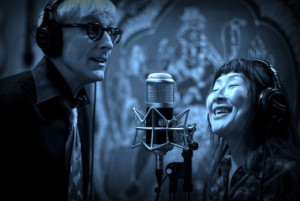
Singing “1,2,3” with Akiko Yano at The Beatles Museum studio. The mic is a Charter Oak. (Photo Credit: Sandrine Lee)
Akiko is someone very special to me. I’ve been on lots of her solo works and we go to Japan each summer for a small tour. We’ve done quite a bit of duo-singing on her shows.
She and I were backstage in Tokyo a couple of years back talking about how much we liked the song and I had always felt it would make a great ballad done in a soft-Brazilian style. So I hit on Giulio Carmassi to help make it a moody, cool groove & he went to town. I guess you could say he gave that song “a Brazilian.” (laughs)
What about the backgrounds?
I asked New York City-based vocalist Tabitha Fair to sing on “Shahara.” She comes from Oklahoma and both of her parents are preachers. She’s real soulful and game for anything.
I sang this sort of Arabic scale to her and she claimed ownership instantly. She started singing this wailing North African riff. She is very musical, very instinctive. On the out chorus, she and another great singer, Neal Coomer, can be heard singing a two-person choir with multiple overdubs. They are both very rangy and came up with all sorts of great parts.
What mics do you have in the Beatles Museum?
I have U87s that were great for the other singers on the CD, but for my voice — which is really thick- I use a Charter Oak. Second choice is AKG413. I have most of what you need including Sennheisers and Neumanns.

Key pieces in The Beatles Museum include the Apogee Rosetta 800 & Big Ben along with Great River Preamp/DI
It sounds like you had an outstanding group of people to go along with the gear.
Even if you are credited as producer, as I am on this CD, usually when you make a recording, there is a team of producers making decisions along the way including the musicians and tracking engineers. (Glenn Ianaro tracked most of the project, Frank Filipetti and Ken Freeman mixed, with Fred Kevorkian doing the mastering).
Of course, it’s great to have a wife, as talented as mine, photographer Sandrine Lee, who can make people look their best for album photos, publicity shots, etc., and graphic artist Ann Lee (no relation), who designed the CD package. These are the people who make songs into a real palatable album project.
What are you working on now or next?
The Fab Faux continues to be a huge passion and a mainstay. I’m continuing sideman work and writing a bunch. I’m also starting to produce again, now that Letterman is coming to an end. The first production project I’ve accepted is “Bluebirds of Paradise,” which is the team of Ari Hest and Chrissi Poland, two great songwriters. I’m really excited about it!
Thanks to SonicScoop – which I’ve been reading faithfully since the beginning!
Credits
Bob James recorded his keyboard solos n Papounets’s Ride at home in Traverse City, Michigan, while Narada Michael Walden laid down drums at his studio in San Francisco.
Steve Luthaker recorded his wailing solo on “Natives” at The Treehouse, LA, recorded by CJ Vanston.
Other studios the LGOD tracks passed through and the engineers who recorded various overdubs include Glen Ianaro at Downtown Studios, drummer Shawn Pelton engineered his own tracks at SP’s Beat Palace, Aaron Walk at Puck Productions, Jim Reitzel at Tarpan Studios, San Rafael, CA; and Zach Danziger recorded his own drum tracks at Deetown, New York City.
Producer: Will produced the lion’s share of the project and credits his engineer, Glen Ianaro, as contributing producer whose input throughout the evolution of the tunes proved invaluable. “We call Glen, the ‘Quiet Man,’” says Will. “On a one-to-one basis, he’s great, never intrusive, and has great chops when it comes to Pro Tools and Logic. “Engineer(s): Glen Ianaro (on tracks recorded by Will; various others as noted above for solos and other overdubs done by artists who performed in the comfort of their homes studios).
Mixers: Frank Filipetti (2,3,4,5,6,7,8,9,10) and Ken Freeman (1,4)
Mastering Engineer: Fred Kevorkian at Kevorkian Mastering.
Label: Will’s Sinning Saint label
See more photos in the gallery below!
— About the author: Roberta “Ro” Lawrence came of age in the recording studio and had the honor of producing sessions with some of the most talented musicians on the planet including Will Lee, Herbie Hancock, Bob James, Mike Brecker, Chris Parker and Steve Gadd. After co-producing “Nightwind” with engineer Larry Gates, and seeing it climb to #5 on the Billboard charts, she opened Roberta Lawrence Media, a public relations and marketing consultancy catering to musicians, studios, pro audio and post production professionals. In January, 2015, she launches Soundcheck PR, a PR and marketing consultancy armed with a highly-motivated and savvy team of publicists who are wholly knowledgeable about publicizing and promoting everything connected to music and sound. Ro also writes about music and postproduction for various publications, or is in the studio working on various projects. Visit her at Soundcheckpr.com and on Facebook.
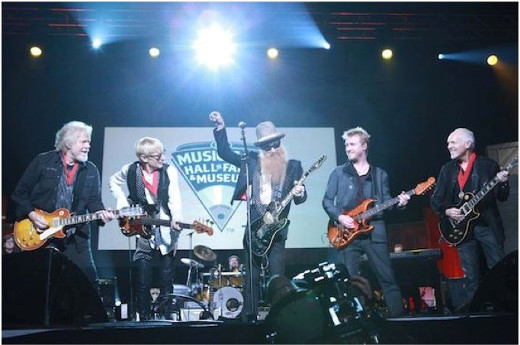
What it’s REALLY all about — jamming. From the Musician’s Hall Of Fame Induction jam in Nashville (l to r: Randy Bachman, Will Lee, Billy Gibbons, Kenny Wayne Shepherd and Peter Frampton). (Photo Credit: Sandrine Lee)
Give a look and listen to “Fooled Him”, the lead single off of LGOD:

Please note: When you buy products through links on this page, we may earn an affiliate commission.







